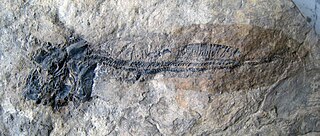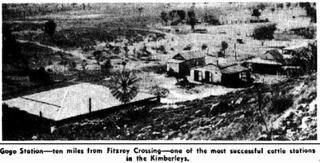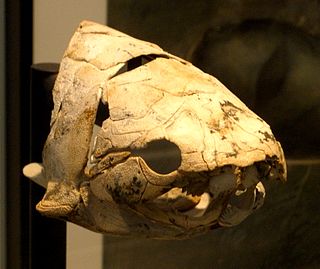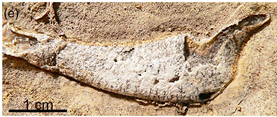
Placoderms are vertebrate animals of the class Placodermi, an extinct group of prehistoric fish known from Paleozoic fossils during the Silurian and the Devonian periods. While their endoskeletons are mainly cartilaginous, their head and thorax were covered by articulated armoured plates, and the rest of the body was scaled or naked depending on the species.

Ctenurella is an extinct genus of ptyctodont placoderm from the Late Devonian of Germany. The first fossils were found in the Strunde valley in the Paffrather Kalkmulde.

Campbellodus decipiens is an extinct ptyctodontid placoderm fish that lived around 380 million years ago. Its fossil remains have been found preserved in perfect three-dimensional form from the Gogo Formation of Western Australia. Originally it was described from large tooth plates and isolated skull roof bones by Miles & Young (1977). Long (1995) restored the complete fish based on new material found at Gogo in the mid 1980s, and described by Long (1997).

Rolfosteus is an extinct monospecific genus of arthrodire placoderm from the Early Frasnian stage of the Late Devonian period, found at the Gogo Formation of Western Australia.

The Gogo Formation in the Kimberley region of Western Australia is a Lagerstätte that exhibits exceptional preservation of a Devonian reef community. The formation is named after Gogo Station, a cattle station where outcrops appear and fossils are often collected from, as is nearby Fossil Downs Station.

Materpiscis is a genus of ptyctodontid placoderm from the Late Devonian located at the Gogo Formation of Western Australia. Known from only one specimen, it is unique in having an unborn embryo present inside the mother, with remarkable preservation of a mineralised placental feeding structure. This makes Materpiscis the oldest known vertebrate to show viviparity, or giving birth to live young.

John Albert Long is an Australian paleontologist who is currently Strategic Professor in Palaeontology at Flinders University in Adelaide, South Australia. He was previously the Vice President of Research and Collections at the Natural History Museum of Los Angeles County. He is also an author of popular science books. His main area of research is on the fossil fish of the Late Devonian Gogo Formation from northern Western Australia. It has yielded many important insights into fish evolution, such as Gogonasus and Materpiscis, the later specimen being crucial to our understanding of the origins of vertebrate reproduction.

Diplocercides is a genus of prehistoric lobe-finned fish belonging to the coelacanth group which lived during the Late Devonian period. Fossils of Diplocercides have been found in Germany, Iran, Ireland, Australia and Poland. In 2010, three-dimensional fossils of Diplocercides were described from the Gogo Formation of Western Australia

Holonema is an extinct genus of relatively large, barrel-shaped arthrodire placoderms that were found in oceans throughout the world from the Mid to Late Devonian, when the last species perished in the Frasnian-Fammian extinction event. Most species of the genus are known from fragments of their armor, but the Gogo Reef species, H. westolli, is known from whole, articulated specimens.

Eastmanosteus is a fossil genus of dunkleosteid placoderms. It was closely related to the giant Dunkleosteus, but differed from that genus in size, in possessing a distinctive tuberculated bone ornament, a differently shaped nuchal plate and a more zig-zagging course of the sutures of the skull roof.

Incisoscutum is an extinct genus of arthrodire placoderm from the Early Frasnian Gogo Reef, from Late Devonian Australia. The genus contains two species I. ritchiei, named after Alex Ritchie, a palaeoichthyologist and senior fellow of the Australian Museum, and I. sarahae, named after Sarah Long, daughter of its discoverer and describer, John A. Long.
Gogodipterus is an extinct genus of prehistoric marine lungfish in the family Chirodipteridae. It contains a single species, G. paddyensis, known from the Late Devonian Gogo Formation of Western Australia. It was formerly placed in Chirodipterus.
Rhinodipterus is an extinct genus of prehistoric dipnoan sarcopterygians or lobe-finned fish, that lived in the Devonian Period, between 416 and 359 million years ago. It is believed to have inhabited shallow, salt-water reefs, and is one of the earliest known examples of marine lungfish. Research based on an exceptionally well-preserved specimen from the Gogo Formation of Australia has shown that Rhinodipterus has cranial ribs attached to its braincase and was probably adapted for air-breathing to some degree as living lungfish are. This could be the only case known for a marine lungfish with air-breathing adaptations.
Deinodus is a form genus that includes two species: the form found in the Onondaga Formation of western New York, Deinodus bennetti, and the form found in the Columbus and Limestone of central Ohio, Deinodus ohioensis. Both species are limited to the Eifelian age of the middle Devonian Period, which occurred 398-391 million years ago.
Camuropiscidae is a family of mostly small, bullet or spindle-shaped extinct arthrodire placoderms from the Late Devonian. With the exception of the snub-nosed Simosteus, camuropiscid placoderms are characterized by an elongated, tubular snout. The entire family is restricted to the Frasnian Gogo Reef Formation of Australia.

Fallacosteus is an extinct monospecific genus of arthrodire placoderm from the Early Frasnian stage of the Late Devonian period, found at the Gogo Formation of Kimberley, Western Australia. As with almost all other camuropiscids, F. turneri had an elongated snout that may have enhanced its hydrodynamic streamlining.

Tubonasus is an extinct monospecific genus of long-snouted arthrodire placoderm from the Early Frasnian stage of the Late Devonian period, found at the Gogo Formation of Kimberley, Western Australia.

Gogoselachus is an extinct genus of cartilaginous fish known from the late Devonian of Australia. It is one of the earliest well-preserved Devonian chondrichthyans, as much more of the fish than just teeth and scales were preserved. This rare preservation reveals some unique discoveries about the evolution of the cartilage that was inside later cartilaginous fish such as sharks, rays, and chimaeras.

Kimbryanodus is a genus of extinct ptyctodontid placoderm fish from the Frasnian of Australia.These placoderms can be told apart from others due to the large eyes, crushing tooth plates, long bodies, reduced armor, and a superficial resemblance to holocephalid fish. The group is so far the only Placoderms known with sexually dimorphic features. The fossils occur as small three dimensional isolated plates. Because of these new specimens the Ptyctodontid grouping got a taxonomic classification, it found that the genus Rhamphodopsis to be the most basal taxa. They are divided by having the more basal taxa having a median dorsal spine, a simple spinal plate, and a simple V-shaped overlap of the anterior lateral and the anterior dorsolateral plates.
Compagopiscis is an extinct genus of placoderm known from the Gogo Formation. It lived in the Upper Devonian of Western Australia. The genus is monotypic, with its only species being Compagopiscis croucheri.















